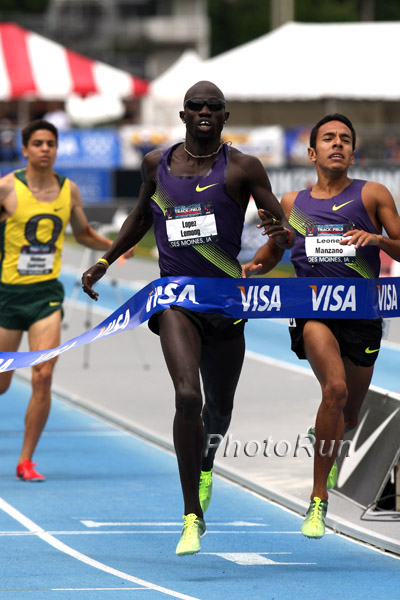Elliott Denman did this thought provoking column on the US flag bearer. Elliott, a 1956 Olympian and long time observer of the sport, will join us in London as a daily columnist on all things track & field and all things Olympics. Elliott has a great sense of history and a wonderful sense of irony in his writing. We hope you enjoy this column.
by ELLIOTT DENMAN
LONDON – It wasn’t track and field’s turn.
Simple as that.
Or was it something much more – in the selection of Team USA’s flag-bearer at the Opening Ceremonies of the XXX Olympiad Friday night ?
There is no doubt whatsoever that the choice of Mariel Zagunis, the two-time gold medal Olympic saber fencer out of Beaverton, Oregon and the University of Notre Dame, to lead her nation’s squad into these third London Olympic Games is a terrific call.
Her story is downright inspirational.
Originally a mere alternate to the American fencing delegation to the 2004 Athens Games, she not only stepped into the fray when a Nigerian athlete’s late scratch created an opening on the start list, but stepped to the very top of the podium by stunning the Europeans who traditionally dominate fencing’s saber dance.
And – amazing but true – this was the nation’s first fencing gold in a century, since the 1904 Games in St. Louis, which was virtually an all-USA event anyway.
Zagunis then repeated in 2008, and with teammtes Sada Jacobson and Becca Ward in the silver and bronze positions gave USA – who’d have ever thunk this possible? – a complete sweep of the medals.
Not only that, she’s a second-generation Olympian; her parents were Olympic rowers in 1976.
Well, MZ’s back in London, she’s back in top form, and she’s going to be mighty tough to keep off the podium once again. So – in this 40th anniversary year of Title IX, a year at which Uncle Sam is sending more of his nieces than his nephews to the Games – she’s a wholely appropriate pick for the honor.
Then again, it gets you thinking.
Is there a story beyond the story?
Is fencing’s gain actually track and field’s loss?
Looking back at the rollcall of past USA flagbearers, the first six were track guys – fieldmen, actually, of the big burly variety who surely had the muscle to do this thing properly.
First of them was shotputter Ralph Rose at London’s first Games in 1908 who decided he’d keep the flag upright past the royal box – ”this flag does not bow to any earthly monarch,” he said – thereby starting the policy – controversial to some – that’s been adhered to by every American flagbearer since.
Of course, Ango-Irish confrontation was at full strength at the time and became one more theme of those ’08 Games.
George Bonhag, the famed distance runner and occasional racewalker – he’d walked to the 1500-meter gold in the still-unofficial Athens Games of 1906 – carried the flag into the Stockholm stadium in 1912 and – following the World War I break – it was NYC policeman Pat McDonald who did the flag honors in 1920 and 1924.
Another muscular thrower, Clarence ”Bud” Houser, did the honors in 1928, followed by 400-meter hurdler F. Morgan Taylor in 1932.
At last/at last, a non-trackman got the job in 1936 – gymnast Alfred Jochim.
Ralph Craig, the 1948 honoree, had a double claim to Olympic fame. He’d won the 100 and 200-meter sprints at the 1912 Games and, 36 years later, here he was back again as an Olympian, this time in the sport of sailing.
Fencer Norman Armitage became the second two-time flagbearer, in 1952 and 1956 (and equestrian Warren Woodford made this list, too, because the 1956 equestrian events were staged not in Melbourne but in Stockholm, thanks to Australia’s immunization fears.)
But trackmen were front and center, leading the delegation at the next two Games, with Rafer Johnson in 1960 and Parry O’Brien in 1964.
Fencer Janice Lee Romary earned the flag assignment in 1968, as the first woman to be so honored, followed by Olga Fikotova Connolly in 1972 (the first naturalized American to take the flag; she’d won the discus gold for Czechoslovakia in 1956.)
Swim champion Gary Hall Sr. – the first representative of his sport to do it – was the 1976 honoree, followed by three more trackpersons – hammerman Ed Burke in 1984, sprinter Evelyn Ashford in 1988 and distance runner Francie Larrieu Smith in 1992.
The flag went to wrestler Bruce Baumgartner in 1996, canoe/kayakist Cliff Meidl in 2000, basketballer Dawn Staley in 2004 and, after a 16-year gap, to a trackman again in 2008,
1500-meter runner Lopez Lomong, once a ”lost boy of Sudan,’ ”
So here we are – 13 trackmen, four fencers, one gymnast, one swimmer, one paddler, one equestrian, one basketballer, one wrestler and one gymnast – all these years later.
Again, no doubt about it, Mariel Zagunis is a marvelous choice.
But there’s no doubt, either, that it’s another sign of the times.
To much of the rest of the world, track and field continues to be the unchallenged flagship sport of the Olympic Games. To much of America, though – thanks muchly to the nabobs of network television – track and field is simply another lively phase of the whole packet.
Until – let’s just say – Usain Bolt runs the 100 meters in 9.2 seconds, or Ashton Eaton totes up nearly 10,000 points – it’s a fact of Olympic life.
Live with it, track fans, it’s the way it is – in 2012 and surely beyond.




















